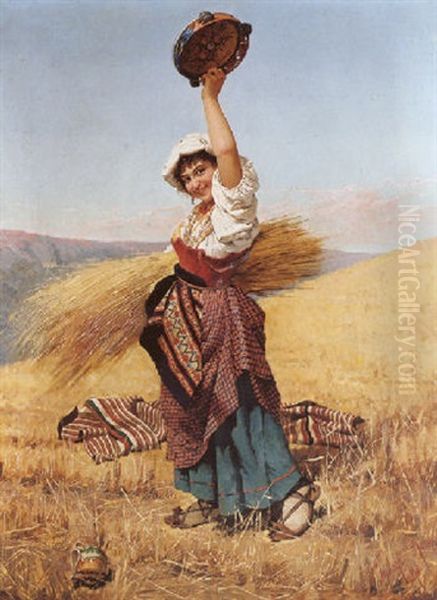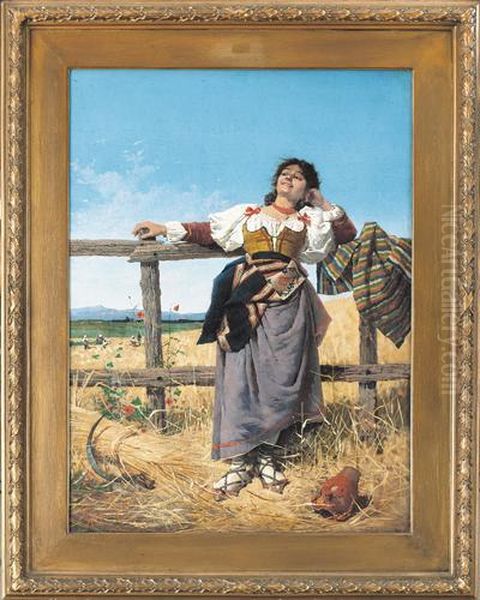Filippo Indoni stands as a notable figure in late 19th-century Italian art. Born in 1842 and passing away in 1908, this Italian painter carved a distinct niche for himself within the broader Realist movement. He dedicated his artistic career primarily to capturing the lives and spirit of Italian peasants and the lower classes, choosing to portray them not with pity, but with a sense of joy, dignity, and pride in their daily existence and simple pleasures. His work, executed in both watercolor and oil, offers a window into an idealized, yet grounded, vision of rural Italy.
A Roman Artist
While detailed biographical records for Filippo Indoni remain somewhat scarce compared to some of his contemporaries, we know he was born in Rome in 1842. His life spanned a period of significant change in Italy, including the Risorgimento and the unification of the country. He lived and worked primarily in Italy, developing a style that became recognizably his own. His artistic activity seems concentrated in the latter half of the 19th century, culminating in his death in 1908. The relative lack of extensive documentation about his personal life perhaps contributes to the focus remaining squarely on his artistic output.
The Essence of Indoni's Realism
Indoni operated within the artistic current of Realism, a movement that sought to depict subjects truthfully, without artificiality or exotic embellishments. However, Indoni’s Realism possesses a unique character. Unlike some Realist painters who focused on the harsh struggles and social injustices faced by the working class, Indoni consistently presented his subjects in moments of happiness, contentment, and communal celebration. His paintings often feature festive atmospheres, warm interactions, and a generally optimistic outlook.

His canvases are frequently characterized by a warm, inviting palette, often dominated by rich amber and earthy tones. This warmth enhances the feeling of comfort and conviviality in his scenes. He depicted idealized rural settings, but populated them with figures whose activities – whether work, music, or courtship – are rendered with a sense of authenticity and vitality. This approach set him apart from the purely sentimental or overly dramatic tendencies found in some strands of Romanticism, while still imbuing his Realism with a distinctly positive and appealing quality.
Mastery of Mediums
Filippo Indoni demonstrated proficiency in both oil painting and watercolor. He is particularly noted for his skill with watercolors, a medium well-suited to capturing the light and atmosphere of the Italian countryside and the vibrant costumes of his subjects. Many of his known works, including genre scenes and portraits, utilize watercolor to great effect, showcasing delicate washes and precise details. His oil paintings often possess a similar warmth and attention to character, bringing his subjects to life with rich textures and colors.
Signature Style
A consistent feature across Indoni's oeuvre is his signature, typically rendered as "F. Indoni". This signature often appears clearly on the face of his paintings and serves as an important element for identification and authentication. Its presence is a hallmark noted by collectors and auction houses dealing with his work. The consistency of his signature aids researchers and connoisseurs in attributing works to him.
Capturing Rural Italy: Themes and Subjects
The heart of Indoni's work lies in its subject matter: the everyday life of Italian country folk. He painted peasants engaged in various activities – tending sheep, working in fields, gathering at markets, or enjoying moments of leisure. Music and dance are recurring themes, with figures often depicted playing instruments like bagpipes or tambourines, suggesting celebration and communal bonding. Courtship and family life also feature prominently, rendered with tenderness and charm.
His depictions often focused on specific regional types, such as the Ciociara, women from the Ciociaria region near Rome, known for their traditional dress. These figures are presented not merely as ethnographic studies, but as individuals imbued with personality and grace. Children frequently appear in his compositions, adding to the sense of innocence and simple joy that permeates much of his work. He aimed to convey the inherent dignity and resilience of his subjects, celebrating their connection to the land and their cultural traditions.
Spotlight on Key Works
Several works stand out as representative of Filippo Indoni's style and thematic concerns.

The Duet (Doppio Gioco): This watercolor, measuring approximately 47 x 32 cm, exemplifies his focus on intimate, joyful moments. The title suggests a scene involving two figures, possibly engaged in music or a shared activity. Its appearance in auction catalogues, with estimates around €300-€500, indicates its recognition within his body of work and its circulation in the art market. It likely showcases his characteristic warmth and skill in watercolor.
Italian Beauty with a Tambourine: Dated 1876, this oil painting (99.5 x 75 cm) is a more formal composition, yet still captures the vibrant spirit often found in his work. The subject, an attractive Italian woman holding a tambourine, combines portraiture with genre elements. Its presence in a private collection and its recorded sale price (around 1.6 million Japanese Yen at one point) attest to its desirability among collectors. It highlights his ability to render textures, costume, and expressive figures in oil.
The Gypsy Girls and The Young Fisherman: Mentioned as notable watercolors, these titles suggest typical Indoni subjects. The Gypsy Girls likely portrays figures often seen on the fringes of society, but probably rendered with Indoni's characteristic sympathetic and lively touch. The Young Fisherman points to his interest in depicting youthful figures engaged in traditional rural or coastal activities. Both works would likely demonstrate his facility with the watercolor medium.
Bagpipe Player with Sheep: This title clearly indicates a pastoral scene, combining music (a common theme) with animal husbandry, central to rural life. It fits perfectly within his preferred subject matter, likely depicting a shepherd entertaining himself or others, embodying the simple, harmonious vision of country existence Indoni favored.
Popolana and Ciociara nella campagna romana: These works, appearing in auction listings with estimates ranging from €400 to €800, further underscore his focus on common folk and regional types. Popolana translates to 'common woman' or 'woman of the people', while Ciociara nella campagna romana specifically places a woman from the Ciociaria region within the Roman countryside. These works likely showcase his skill in depicting traditional attire and placing figures naturally within landscape settings.
Indoni in the Italian Art Landscape
Filippo Indoni worked during a vibrant period in Italian art. The latter half of the 19th century saw the flourishing of various Realist tendencies across the peninsula. In Tuscany, the Macchiaioli group, including artists like Giovanni Fattori, Telemaco Signorini, Silvestro Lega, and Giuseppe Abbati, developed a distinctive style characterized by patches (macchie) of color and light, often depicting scenes of contemporary life, landscapes, and historical events related to the Risorgimento.
Further south, particularly in Naples, artists like Domenico Morelli and Filippo Palizzi (along with his brother Giuseppe Palizzi) explored different facets of Realism, from historical subjects to detailed animal studies and genre scenes. Francesco Paolo Michetti became renowned for his vibrant depictions of life in the Abruzzo region, often focusing on pastoral and folk traditions with dramatic flair. Antonio Mancini, known for his psychologically intense portraits and use of thick impasto, also emerged from this Neapolitan milieu.
While Indoni shared the Realist interest in contemporary subjects and ordinary people, his consistent focus on cheerful, idealized scenes distinguishes him from the often more politically charged or socially critical work of some Macchiaioli, or the sometimes grittier realism found elsewhere. He seems less concerned with capturing fleeting atmospheric effects like the Macchiaioli or the intense psychological states explored by Mancini, preferring instead to create well-composed, pleasing narratives of rural contentment. His work aligns comfortably with a broader European tradition of genre painting that found renewed vigor under Realism, represented by artists like Giuseppe De Nittis, an Italian who found great success in Paris.
Contemporaries Near and Far
The provided information mentions several other Italian artists chronologically adjacent to Indoni, such as Renato Natali (1883-1979) and Cafiero Filippelli (1889-1973). While significantly younger, their work in the early 20th century continued traditions of Italian painting. Giuseppe Gabani (1866-1900) and Virgilio Colombo (fl. late 19th/early 20th c.) were closer contemporaries, working in similar periods, though specific interactions or collaborations with Indoni are not documented.
Looking beyond Italy, Indoni's focus on peasant life resonates with the work of French Realists. Jean-François Millet famously depicted the hardships and dignity of rural labor in works like The Gleaners. However, Indoni’s emphasis is markedly different, leaning towards joy rather than solemnity. Jules Breton, another French painter, also specialized in idealized scenes of peasant life, perhaps offering a closer parallel in terms of sentiment, though stylistically distinct. The broader Realist movement, spearheaded by figures like Gustave Courbet in France, provided the overarching context for artists like Indoni who turned away from academic Neoclassicism and Romantic exoticism towards the depiction of everyday reality, albeit interpreted through their own individual lenses.
The Market for Indoni
Filippo Indoni's paintings have maintained a consistent presence in the art market, particularly at auction. His works, especially watercolors and characteristic oil paintings featuring attractive figures and pleasant scenes, are sought after by collectors of 19th-century European genre painting. Auction estimates cited range from a few hundred euros for smaller watercolors (like Doppio Gioco at €300-€500) to higher figures for more substantial oils or particularly appealing subjects (like Ciociara nella campagna romana estimated at €600-€800).
The sale of Italian Beauty with a Tambourine for a significant sum further demonstrates the market's appreciation for his more finished oil paintings. This steady market presence suggests an enduring appeal, likely due to the decorative quality of his work, its accessible subject matter, and its nostalgic evocation of a seemingly simpler, happier past. His paintings offer a pleasing glimpse into Italian folk life, rendered with competent technique and a consistently positive tone.
Authentication and Value
As with many artists from past centuries whose works circulate on the market, authentication is an important aspect for collectors of Filippo Indoni. The existence of services providing research, authentication, and Certificates of Authenticity (COA) for his work highlights this need. Establishing the authenticity of a painting attributed to Indoni is crucial for confirming its value. Experts rely on stylistic analysis, comparison with known works, signature verification, and provenance research to make these determinations. The demand for such services indicates that his works are considered valuable enough to warrant careful verification.
Rediscovery and Legacy
While perhaps not always placed at the forefront of major art historical narratives focused on groundbreaking movements, Filippo Indoni has enjoyed a degree of rediscovery and sustained appreciation, particularly in the 21st century. His work continues to surface in galleries and auction houses, suggesting a lasting interest among collectors and enthusiasts of 19th-century Italian art.
His legacy lies in his specific contribution to Realist genre painting. He carved out a niche by focusing almost exclusively on the positive aspects of peasant life, celebrating community, music, and simple pleasures. While some might view his depictions as overly idealized or romanticized, they represent a valid artistic choice and perspective within the broader spectrum of Realism. He offered an alternative to depictions of rural hardship, choosing instead to highlight the resilience, dignity, and capacity for joy among the Italian common folk. His paintings remain appealing for their charm, warmth, and skillful execution.
Concluding Thoughts
Filippo Indoni remains a significant figure for those interested in 19th-century Italian genre painting. As an artist rooted in Realism but guided by a distinctly optimistic vision, he created a body of work that celebrates the life and spirit of rural Italy. Through his adept use of watercolor and oil, his warm palette, and his focus on joyful moments and communal bonds, he captured an idealized yet relatable image of peasant existence. His paintings continue to find appreciative audiences, valued for their aesthetic appeal, technical skill, and charming portrayal of a bygone era. He stands as a testament to the diverse ways artists engaged with the realities of their time, choosing to emphasize light and happiness within the everyday lives of ordinary people.